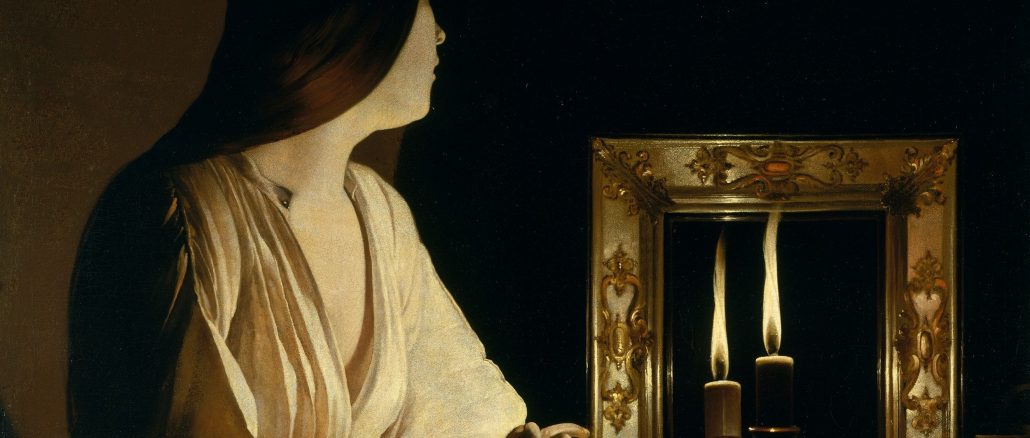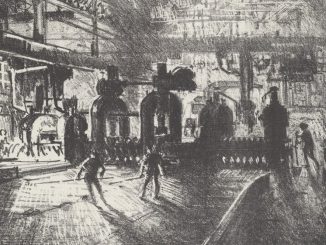
We all have memories, but not everyone wants to turn their memories into memoir or to shape their life experiences into art. For those of us who want to do it, who must do it, the challenge can be daunting. But in order to turn a life into a memoir, we must cultivate the art of looking back.
The past is in the past.
I pulled the dress out of the back of my closet. I hadn’t looked at it in years. There were stains that had appeared over time but much of the dress was still in good condition. I unzipped the back and turned it inside out and picked at the seams. I began the slow process of taking it apart, piece by piece, thread by thread, separating the sleeves from the bodice, letting out the hem of the skirt and finally pulling out the long threads to ungather the folds of the skirt. The past is in the past.
Such a phrase can be comforting. The idea of a fresh start, of becoming a different person, of forgetting the pain of past deeds, is perhaps an easy answer to solving life’s problems. But for me the past has always been integral to my present experience, and while memories can feel fragile at times, I didn’t know the strength of a single thread until I tried to break one.
When I was very young I slept under a handmade quilt in my crib. It was all the cut up clothes from my older brothers and sisters, square patches sewn together with colored thread to form a blanket that I slept under. I loved to run my hand along the surface of the quilt and feel the different textures of fabric: the soft flannel of an old nightgown, the smooth slickness of a polyester blouse, heavy corduroy pants, a stiff cotton skirt, and even one patch that had the button placket of a shirt sewn right in, buttons and all. Sometimes at night when I wasn’t quite tired enough to sleep I would pick at the threads that held all the squares together until I had made a small opening, a pocket that I could fit my hand into perfectly and run my fingers along the scratchy batting, feeling the insides of the quilt.
Looking back is not just remembering, it is a process of searching and excavating and even of picking apart. It is seeing what hasn’t been noticed before, observing memories that have faded to the background or have been hidden because they were too uncomfortable to deal with at that time, turning everything inside out and unraveling the old threads. Memories are the raw materials and those specific moments, the ones that stand out bright against the canvas of the past, can be the thin fibers that bind the memories together. Where are those threads? What do I see when I look back into my past?
I see a girl of about thirteen. She wears an impossibly ugly dress. Brown and mustard yellow, with a tight collar that might be strangling her, and a bunched elastic waistband that rides up to her ribcage. The dress: obviously too small. Her long, dark hair is parted in the middle and worn in two braids, but one of those braids is unraveling, the elastic band broken. She wears white cotton tights, a stark contrast against the heavy brown skirt of her dress. Big, thick-soled leather shoes bind her feet; the laces are loose and dragging on the floor. Her shoes make a clomp-clomp-clomp sound, which she emphasizes by stomping just a little when she walks. Clomp, clomp, clomp. She laughs too loudly and too much and talks too fast. “Obnoxious,” she is called. “Ugly,” she is called. Only no one ever said she was ugly. Just herself. One thread.
She carries a load of folded clothes in a laundry basket up the basement stairs and through the kitchen. The house is not nearly big enough for the thirty or so kids that live in it. She lifts the basket over her head and past a long row of high chairs lining the kitchen wall, each one holds a small person, bibbed and waiting for food to be placed on the metal tray. She hurries upstairs to put the clothes away. Bedrooms are overcrowded with bunk beds and cribs; bathroom cupboards are full of worn towels and stacks of sheets. She arrives for dinner at the cloth covered folding table with all the other boys and girls crammed into metal chairs. I see her find her place, squeezing in between two other chairs and settling in her spot. Her spot. Her place. And she disappears there, camouflaged by so many others. Her shoes hidden under the table, her messy hair brushed back and tucked behind her ears. Another thread.
Later that night, when the house is dark and the family asleep, she creeps out of her bed in the basement and stands at the kitchen sink to get a drink of water. But she isn’t there for a drink of water. She looks at her reflection in the darkened kitchen window. It’s the only time she feels truly unwatched and alone. Her long hair has been brushed out and drapes over her shoulders. Her robe closes to a deep V shape accentuating her newly forming woman shape. She cinches the ties. The girl in the window is almost pretty and she notices the smooth curve of her lips, the gentle roundness of her cheekbones, and when she looks right at her there is intelligence in her eyes. The girl in the window looks away and fills a glass with water. But in her peripheral vision she keeps watching her, an apparition from another time, a future that is waiting for her across the chasm of reality. And another thread.
The thirteen-year-old girl doesn’t know any of this exactly. She just acts according to how she feels. I can see now, looking back, what I couldn’t see then. I can connect the threads that have been long broken. The memory is simple, clear, vibrant. Me, in a too-small dress, my hair a mess, and my big clodhoppers, the laundry basket on my hip, the kitchen table, the babies in the lined-up high chairs, the empty metal seat that was mine and how I slipped in beside my brothers and sisters. But that is not the story. The story is about a girl who is afraid to fit in and by doing so disappears. She finds privacy in her loudness and sanctuary in her ugliness: like a chicken costume she wears so well she is slowly losing her original self, the one that makes the arms and legs move, who sweats and strains inside it, all to be untouchable, to escape the storm that will break of her soul into parts too small to be recovered. To hide. And later in the dark of night she will rendezvous with herself at the kitchen sink and in that shadowy distortion of the window reflection, she will remember herself again.
What that young thirteen-year-old girl doesn’t know is that she will wear the loud, ugly suit so long and so well that it will grow into her, become a part of her like a tree growing around an object left on a branch, responding to it like a wound. When she wants to shed herself of that protection, she will discover she has absorbed the foreign object into herself and she is no longer one or the other, but both.
The memory of myself hauling laundry up the basement stairs and later standing alone at the kitchen sink is not just a memory. It has remained vivid and clear because it is loaded with meaning. Hidden in those tangible images are the motivations, feelings, and thoughts held in place by the magic of the mind. I remembered it because it captured a truth and rendered it in perfect likeness, a fossil of a moment that reveals more than itself. When I really look, it reveals to me the parts of my life I tried to forget. The smallness of that false self I forced myself into and strained beneath, the desperate attempt to control my life and the way it all unraveled and pushed its way out of its bonds as I was pushing out of the braid of my own making and, finally, so many years later, finding that I am still held firm by those moments, still somehow trapped in amber.
The thing is, my survival came at a price. I thought I could save myself without any consequences and that I could hide without getting lost. This is the discovery of looking back. Those threads, when woven together, form a picture that reveals something truer than the sum of its parts. A memory, tied to a feeling, connected to thoughts and motivations, illustrated by a moment in time.
I cut the dress up into many different sized patches and then refitted the pieces arranging them to form a new whole. The threads I used to stitch those scraps together are fragile and yet strong enough to hold it all together. When the quilt was finished I ran my hand along the surface and remembered each piece and yet saw it anew.
But there is one more final thread, the one that binds me to you. When I share this moment, one that has always been private to me until now, I am weaving a new thread, the one that I am asking you to pick up and to hold. By sharing it I ask you to bring to it your own experience and to tie me to you. That is what memoir is about and that is the true art of looking back. The past is not in the past. It is right here in my hands and in yours.
SUSANNA BARLOW is a full-time writer. Her memoir Not in My House is about her life in a polygamous family and how she overcame the struggle of surviving abuse. It won First Place for Creative Nonfiction in the Utah Original Writing Competition 2017. An excerpt of her book was published in Artists of Utah 15 Bytes in 2018. She enjoys helping other writers with one-on-one writing guidance and as a developmental editor.
Twitter: susanna_barlow
Featured image: Georges de La Tour, “The Penitent Magdalen,” oil on canvas, ca. 1640, gift of Mr. and Mrs. Charles Wrightsman, 1978, The Metropolitan Museum of Art.



